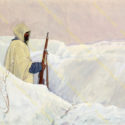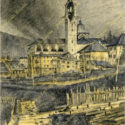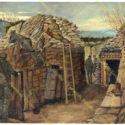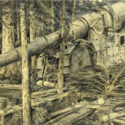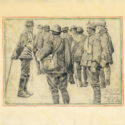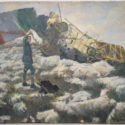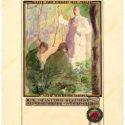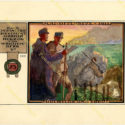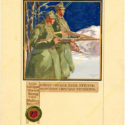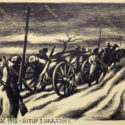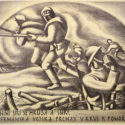 Exhibition marking the centenary of the end of World War I
Exhibition marking the centenary of the end of World War I
Terezín Memorial, foyer of the Small Fortress cinema
September 13 – November 28, 2018
The First World War brought death and suffering to dozens of millions of people. The exhibition depicts this war conflict through the works of art from the collections of the Terezín Memorial. The key exhibits in the first part of the display are drawings and paintings by Theodor Lindner and Hans Denk depicting combat operations and everyday life of the Austro-Hungarian troops from the Cheb-based Infantry Regiment No. 73 in the Serbian, Russian and Italian battlefields. This particular unit fought in the same battlegrounds as the Terezín Infantry Regiment No. 42, but unfortunately no works of art are available in the Terezín Memorial featuring this regiment. On display in the second part of the exhibition, dedicated to the battles waged by the Czechoslovak Legions until the end of World War I, are cycles of lithographs by Otto Matoušek entitled Zborov and Bakhmach. The Czechoslovak Legions were formed in Russia, France and Italy as a voluntary army fighting on the side of the Entente powers against Austro-Hungary and Germany. The successes scored by the Legions made a decisive contribution to the international recognition of the rights of the Czechs and Slovaks to their own independent state and significantly supported the Czechoslovak politicians in exile in their activities. The displayed artworks are supplemented with many other exhibits.
Hans Denk (* 1888 Greiz, † 1971 Heilbronn) graduated from the Academy of Fine Arts in Vienna; in his career he focused mainly on portraiture and posters. Since his childhood he lived and worked in Mariánské Lázně (Marienbad) where he also designed the painterly decorations of the local Russian church. Just as Theodor Lindner, Denk spent the First World War fighting in the ranks of the 73rd Infantry Regiment. After World War II he was probably moved to the US occupation zone in Germany.
Theodor Lindner (* 1882 Düsseldorf, † 1956 Düsseldorf) attended the Düsseldorf College of Applied Art between 1902 and 1904. He applied himself primarily to genre painting with subjects depicting life in the 18th and first half of the 19th centuries. During World War I he served in the Cheb-based Infantry Regiment No. 73 (as an Austro-Hungarian national). He was seriously wounded in the Russian front on June 30, 1915 and that is why his works from the second half of 1915 are missing in the set of his art capturing the campaigns waged by the Regiment No. 73.
Otto Matoušek (*1890 Plzeň, † 1977 České Budějovice) studied at the Prague Academy of Fine Arts between 1910 and 1914. In 1915 he began his military service in the Pilsen-based 35th Infantry Regiment and left for the Russian front where he was soon taken prisoner. Following his application, in July 1916 he enlisted in the Czechoslovak Legions, passed a training course for commissioned officers and then held various command posts. After his returned home he stayed in the Army and ended his CO career due to poor health in March 1938. During World War II he joined the underground Nazi resistance movement, was arrested in March 1943 and imprisoned until the end of the war. The themes associated with the Czechoslovak Legions figured prominently in his works.
Department of Collections, Terezin Memorial
- Theodor Lindner, 1917. An Austro-Hungarian soldier in a winter camouflage outfit standing on guard near Monte Zebio, PT 4908.
- Theodor Lindner, 1916. Burning church in Asiago, captured by the Austro-Hungarian units on May 31, 1916, PT 4902.
- Theodor Lindner, 1916. Advanced position near the town of Monfalcone in the southern sector of the Italian front, PT 4911.
- Theodor Lindner, 1916. Captured Italian 254 mm cannon, PT 4916.
- Theodor Lindner, 1916. Italian troops captured on May 25, 1916 during the fighting for the peak of Monte Meatta. An Austro-Hungarian guard standing on the left, PT 4918.
- Theodor Lindner, 1916. Italian reconnaissance plane shot down near Casara Zebio on October 13, 1916, PT 4972.
- Hans Denk, 1915. Field mass at the Russian front, PT 4999.
- Hans Denk, 1915. Offensive on the eastern front in May 1915 following the breakthrough near the town of Gorlice, PT 5001.
- Hans Denk, 1915. Sentry in the Carpathians, PT 5003.
- Otto Matoušek, 1938. Retreat from Ukraine (from the cycle Bakhmach), PT 14045, © Luisa Matoušková, Otta Matoušek.
- Otto Matoušek, 1927. Fighting (from the cycle Zborov), PT 14052, © Luisa Matoušková, Otta Matoušek.
- Otto Matoušek, 1927. After the Battle (from the cycle Zborov), PT 14053, © Luisa Matoušková, Otta Matoušek.

